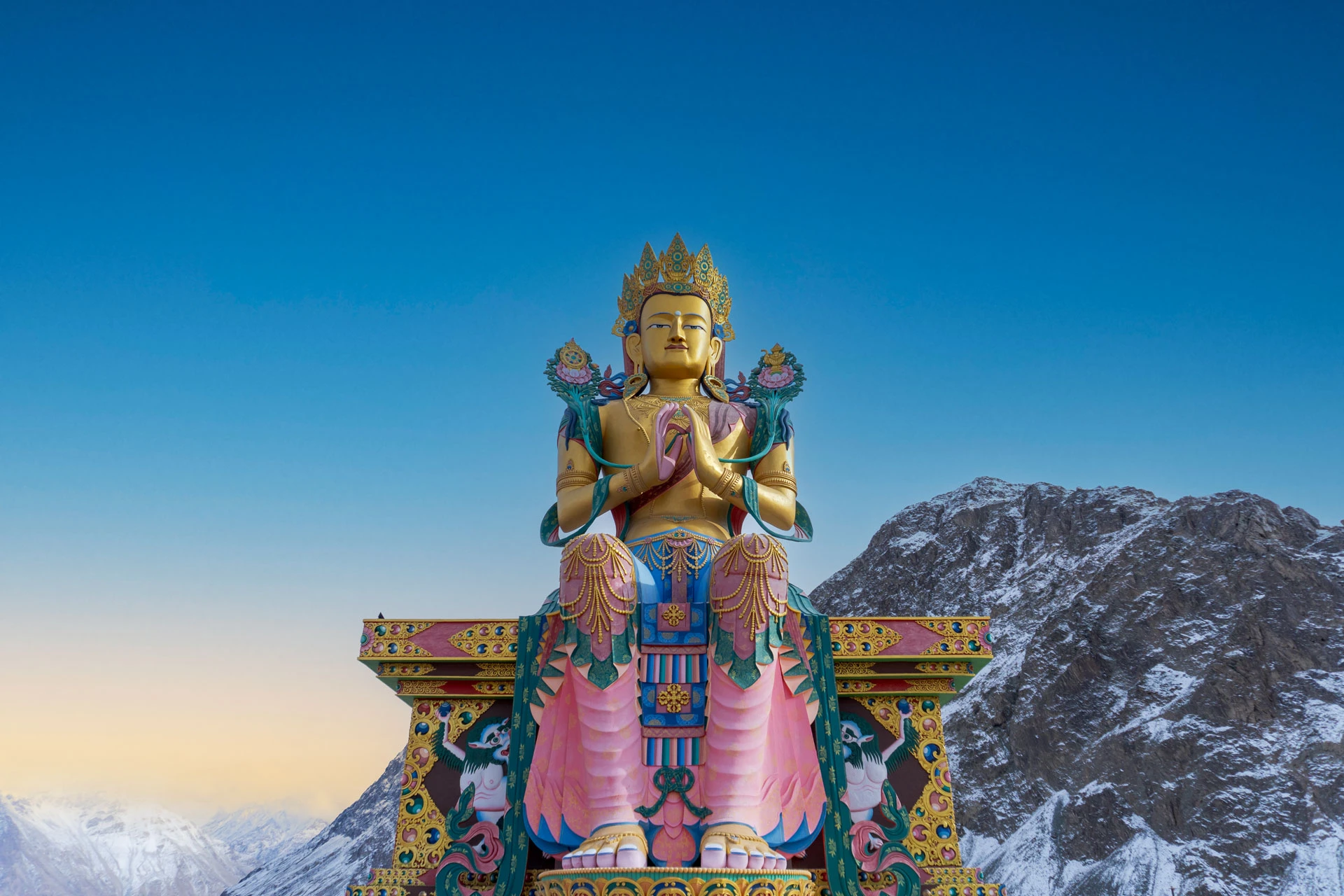A trip to Ladakh is a dream journey for both adventure seekers and nature lovers. This 6-day expedition covers the best of Ladakh, starting from Leh and taking you through some of the region’s most iconic destinations like Leh Palace, Shanti Stupa, Hall of Fame, Magnetic Hill, and the confluence of the Indus and Zanskar rivers.
The adventure intensifies as you travel to Nubra Valley via Khardung La Pass, one of the highest motorable roads in the world. In Nubra, enjoy the dunes of Hunder and a unique camel ride on double-humped Bactrian camels. Your Ladakh trip continues to the mesmerising Pangong Tso, a high-altitude lake known for its changing shades of blue. On the way back to Leh, visit famous sites like Thiksey Monastery and Shey Palace.
Throughout this Ladakh trip, you’ll stay in comfortable hotels, camps, and cottages, experience local hospitality, and capture stunning Himalayan vistas. From cultural encounters to thrilling drives, a trip to Ladakh offers an unforgettable blend of adventure, serenity, and natural beauty.
Things to do in Ladakh Trip
Drive Through High Mountain Passes: Experience thrilling drives over Khardung La and Chang La, two of the world's highest motorable passes.
Explore Nubra Valley: Enjoy camel rides on the Hundar dunes and visit the serene Diskit Monastery.
Local Sightseeing in Leh: Visit the iconic Leh Palace, serene Shanti Stupa, bustling Leh Market, and the Hall of Fame museum..
Try Local Cuisine: Savour authentic Ladakhi dishes, including thukpa, momos, butter tea, and skyu.
Experience Ladakhi Hospitality: Stay in cosy camps, cottages, and guesthouses, and enjoy the local culture and warm hospitality.
Attractions
Leh Palace: Leh Palace, a nine-story historic structure constructed in the 17th century by King Sengge Namgyal, served as the royal residence of the Namgyal dynasty. Showcasing medieval Tibetan architecture, it bears a striking resemblance to Lhasa's Potala Palace. Perched atop a hill, the palace offers panoramic views of Leh town and the Stok Kangri mountains. Inside, you’ll find ancient murals, Buddhist relics, and old photographs that depict Ladakh’s royal heritage. Though partially in ruins, Leh Palace remains a symbol of Ladakh’s rich history and culture. It’s a must-visit for those interested in architecture, history, and photography during a trip to Leh.
Shanti Stupa: The Shanti Stupa is a beautiful, white-domed Buddhist monument situated on a hilltop in Leh. Built in 1991 by Japanese monks and Ladakhi Buddhists, it symbolises world peace and harmony. The stupa houses sacred relics of the Buddha, enshrined by the 14th Dalai Lama. Its architecture is simple yet striking, with intricate carvings and golden Buddha statues. The stupa is especially popular for sunrise and sunset views, offering a panoramic spectacle of Leh town and the surrounding mountains. Beyond its spiritual significance, Shanti Stupa serves as a peaceful retreat for meditation and reflection, making it a must-visit spot in Ladakh.
Hall of Fame: Hall of Fame stands as a powerful tribute to the valour and sacrifices of the Indian Armed Forces in Ladakh. Established in 1986 and significantly upgraded in 2015, this two-storey museum features galleries dedicated to conflicts from the 1947 war to Kargil and high-altitude operations on Siachen. On the ground floor, visitors explore Ladakh’s cultural heritage, Indo-China war stories, and poignant sections like “Lest We Forget,” which honours fallen heroes Upstairs, displays focus on Operation Vijay, showcasing captured arms, gear, and the iconic “Last Post” letter from Captain Vijayant Thapar The external complex includes a war memorial, cemetery, adventure park, and souvenir shop all set against the stunning Himalayan backdrop near Leh Kargil road With its immersive mix of military history and regional culture, the Hall of Fame is a compelling stop for every traveler to Leh.
Magnetic Hill: Magnetic Hill, located near Leh, is one of Ladakh's most curious attractions, renowned for its gravity-defying phenomenon. Situated on the Leh-Kargil highway at an altitude of approximately 14,000 feet, this stretch of road creates a fascinating optical illusion, making vehicles appear to roll uphill against gravity when left in neutral gear. While some believe it’s due to strong magnetic forces, the effect is a result of the surrounding landscape’s unique alignment, which tricks the eyes. Despite scientific explanations, Magnetic Hill continues to intrigue tourists and remains a popular stop for travelers exploring Ladakh, offering both mystery and stunning Himalayan views.
Gurudwara Pathar Sahib: Gurudwara Pathar Sahib is a revered Sikh shrine situated approximately 25 km from Leh, on the Leh-Kargil highway, at an elevation of around 12,000 ft above sea level. It commemorates Guru Nanak’s visit during his third Udasi around 1517, when a demon cast a massive boulder at him. Still, the stone became soft like wax, imprinting the Guru’s form and even trapping the demon’s foot. Discovered during 1970s road construction, the boulder resisted removal. It was later enshrined within the Gurudwara, which was built in the 1960s and 1970s with the help of the Indian Army, local Lamas, and villagers.
Indus–Zanskar Confluence: The Indus–Zanskar Confluence, also known as the “Sangam,” is a striking natural spectacle situated approximately 35 km from Leh, near Nimmu. Here, the emerald-green Zanskar River meets the sapphire-blue Indus River in a breathtaking display of contrasting hues. Formed by tributaries originating in the high Himalayas, the Zanskar River slows in winter, often freezing completely, while the Indus continues flowing, creating a dynamic seasonal tableau. This location is popular for river rafting, offering moderate Grade 2–3 rapids on the Indus River, while the Zanskar River presents more intense and challenging sections for adventure enthusiasts.
Khardungla Pass: Perched at an elevation of 18,380 feet (5,602 meters), Khardung La is among the world’s highest motorable passes. Approximately 40 km from Leh, it acts as a crucial entry point to the scenic Nubra and Shyok Valleys. Khardung La, built in 1976 and opened to the public in 1988, holds historical significance as part of the ancient Silk Road, which once facilitated trade between India and Central Asia. Today, it is maintained by the Border Roads Organisation and remains vital for transporting supplies to the Siachen Glacier. Travellers often stop here to capture breathtaking Himalayan views and experience the thrill of high-altitude travel.
Diskit Monastery: "Diskit Monastery, the oldest and most prominent monastery in Nubra Valley, stands as a symbol of the region’s spiritual heritage and history. Constructed in the 14th century, it is part of the Gelugpa sect of Tibetan Buddhism. Perched on a hilltop, the monastery offers breathtaking views of the Nubra Valley and the Shyok River. Its walls are decorated with ancient frescoes and murals, while the prayer halls house centuries-old scriptures and images of Buddhist deities. Diskit Monastery is also renowned for its towering Maitreya Buddha statue, a striking symbol of peace and compassion.
Hunder Sand Dunes: The Hunder Sand Dunes, located in the Nubra Valley of Ladakh, offer a rare and unique desert experience amidst snow-capped mountains. Unlike typical deserts, Hunder’s dunes are set against a backdrop of rugged landscapes and cold desert terrain. This area was once part of the ancient Silk Route, and its historical significance adds to the allure. The dunes are home to the famous double-humped Bactrian camels, once used by traders for transportation across Central Asia. Visitors can enjoy camel rides across the soft, white sands while soaking in the surreal scenery. The cool breeze and stunning views make Hunder an unforgettable experience.
Nubra Valley: Nubra Valley, often referred to as the "Valley of Flowers of Ladakh," is a high-altitude desert situated north of Leh. Formed by the confluence of the Shyok and Nubra rivers, the valley is renowned for its lush greenery amidst arid mountains, ancient monasteries, and picturesque villages. Historically, the Nubra Valley was a vital part of the Silk Road, connecting traders from Central Asia to Ladakh. The valley is renowned for its attractions, including the Diskit Monastery, Hunder Sand Dunes, and the rare double-humped Bactrian camels. Its serene landscapes, vibrant cultural heritage, and breathtaking scenery make the Nubra Valley a must-visit destination during any trip to Ladakh.
Pangong Lake: Pangong Lake, also known as Pangong Tso, is one of Ladakh's most mesmerising natural wonders. Situated at an altitude of 13,860 feet (4,225 meters), this high-altitude lake stretches over 134 kilometres, extending from India into Tibet. Pangong Lake is famous for its crystal-clear waters, which change colour throughout the day, shifting from shades of blue to green and even golden hues under different lighting conditions. The lake gained international fame after being featured in the Bollywood movie *3 Idiots*. Though Pangong Lake is saline, it astonishingly freezes solid during the harsh Ladakhi winter, transforming into a vast sheet of ice.
Chang La Pass: Chang La Pass, situated at an altitude of 17,586 feet (5,360 meters), is one of the world's highest mountain passes. Located on the way from Leh to Pangong Lake, it serves as a crucial gateway to eastern Ladakh. The pass is known for its steep climbs, rugged terrain, and breathtaking views of snow-covered peaks. Despite its challenging conditions, Chang La is a popular stop for travellers due to its scenic beauty and the thrill of high-altitude driving. A small temple at the top, dedicated to the Changla Baba, is believed to protect travellers crossing the pass.
Thiksey Monastery: Thiksey Monastery, often referred to as the "Mini Potala of Ladakh," is a magnificent twelve-story structure situated approximately 19 km from Leh. It's an essential centre of the Gelugpa or Yellow Hat sect of Tibetan Buddhism. Its grand architecture, sprawling across a hillside, closely resembles the iconic Potala Palace of Lhasa, making it one of the most visually striking monasteries in Ladakh. Inside, you'll find beautiful murals, ancient scriptures, and a 49-foot-high statue of Maitreya Buddha, one of the largest in Ladakh. Thiksey Monastery is home to a rich collection of spiritual treasures, including beautifully decorated stupas, ancient thangkas (Tibetan Buddhist paintings), and a variety of ceremonial objects.
Shey Palace: Located just 15 km from Leh, Shey Palace was built in the 17th century by King Deldan Namgyal. Perched atop a hill, it offers panoramic views of the Indus Valley. The palace is home to a stunning 12-meter-high gilded statue of Shakyamuni Buddha, one of the largest in Ladakh, crafted from copper and gold. Once an important cultural and administrative centre, Shey Palace now stands partially in ruins. Despite this, its historical significance, tranquil atmosphere, and the nearby monastery make it a must-visit destination in Ladakh.





